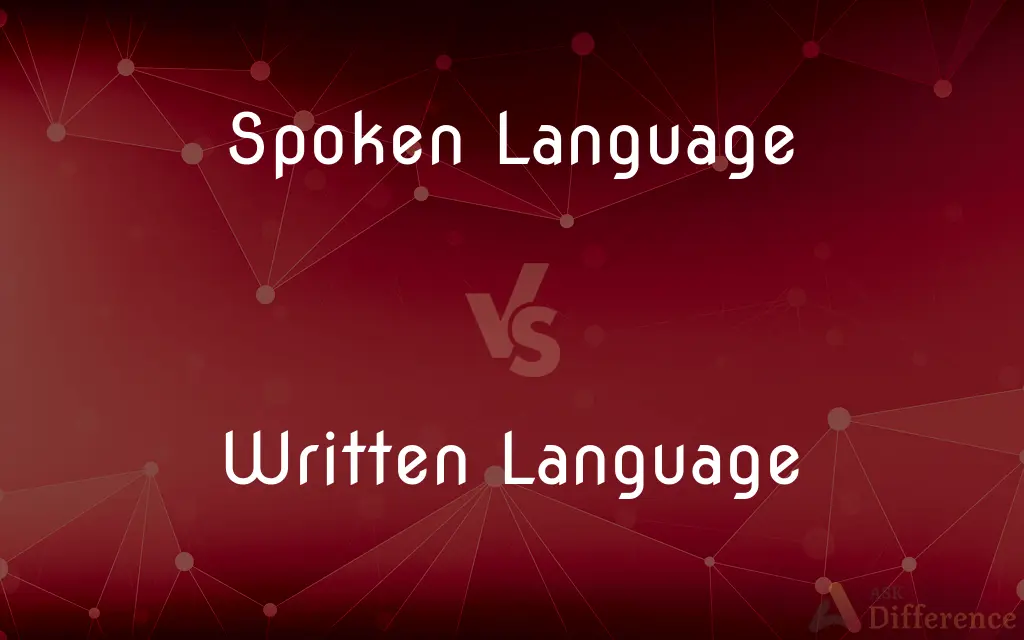Spoken Language vs. Written Language — What's the Difference?
By Tayyaba Rehman — Published on October 17, 2023
Spoken Language involves verbal communication and employs phonetics, while Written Language uses symbols or letters and adheres to grammatical and structural rules.

Difference Between Spoken Language and Written Language
Table of Contents
ADVERTISEMENT
Key Differences
Spoken Language embodies the vocalized form of communication where words and sentences are produced using the mouth and voice. Contrarily, Written Language leverages symbols, often in the form of alphabets or characters, composed to convey messages and is not vocal. Spoken language usually allows for a more personal, emotive communication style, while written language often demands adherence to established grammatical norms and structures, ensuring clarity and precision in transmission.
Exploring the nuances of Spoken Language reveals an allowance for improvisation, employing non-verbal cues, such as tone, pitch, and pace, which can significantly impact the message's intent and reception. In contrast, Written Language necessitates the usage of punctuation, formal structures, and standardized grammar to convey similar nuanced meanings, utilizing explicit markers to indicate tone and intent which spoken language conveys through auditory cues.
Diving into the dynamics of interaction, Spoken Language can be momentary and spontaneous, providing immediate feedback and fostering dynamic two-way communication. Written Language, conversely, often facilitates a more calculated, thoughtful expression of thought, where messages can be reviewed and refined before transmission, enabling a persistent record of communication that can be revisited and analyzed.
Engaging with Spoken Language, one encounters the immediate and ephemeral nature of vocal communication, subject to real-time modifications and unable to be referenced in future unless recorded. Oppositely, Written Language proffers permanence and traceability, with messages and information stored, potentially reviewed, and analyzed longitudinally, serving as a historical record of communication exchanges.
In educational and professional settings, Spoken Language frequently empowers quick, collaborative, and adaptive communication, advantageous in discussions and cooperative environments. In contrast, Written Language often provides a documented, verifiable medium of information exchange, crucial in legal, academic, and professional documentation, ensuring accountability, traceability, and exactness in informational transfer.
ADVERTISEMENT
Comparison Chart
Medium
Vocal/auditory
Symbols/visual
Formality
Generally more informal
Tends to be more formal and structured
Non-verbal cues
Uses tone, pitch, and pace
Employs punctuation and formatting
Permanence
Ephemeral unless recorded
Permanent and traceable
Feedback
Immediate and dynamic
Can be delayed and static
Compare with Definitions
Spoken Language
Auditory communication using structured vocal sounds.
He conveyed his thoughts clearly through Spoken Language.
Written Language
A tangible or visual form of linguistic communication.
Written Language can be analyzed and critiqued for clarity.
Spoken Language
Verbal expression utilizing phonetics.
Spoken Language can adapt to various conversational contexts.
Written Language
Conveyance of language through physical or digital inscription.
Written Language provides a permanent record of exchanges.
Spoken Language
Language conveyed through audible means.
Her proficiency in Spoken Language is evident in her eloquence.
Written Language
Language manifested in a visual format.
His Written Language skills are demonstrated in his essays.
Spoken Language
Communication through vocalized words and sounds.
Spoken Language allows for lively and immediate interaction.
Written Language
Language expressed using structured symbols or letters.
Written Language demands a solid understanding of grammar.
Spoken Language
Language expressed using voice and oral articulation.
Spoken Language facilitates quick, spontaneous communication.
Written Language
Communication through inscribed or printed symbols.
Written Language enables detailed documentation of events.
Common Curiosities
Does Written Language always follow strict grammar rules?
Generally, Written Language adheres more closely to grammatical rules.
Can Written Language convey emotion effectively?
Written Language can convey emotion, often through word choice and punctuation.
Is Written Language always permanent?
While traditionally more permanent, Written Language can be ephemeral in digital forms.
What is a key feature of Spoken Language?
Spoken Language typically allows for immediate, dynamic interaction.
Can Spoken Language incorporate non-verbal cues?
Yes, Spoken Language often includes non-verbal cues like tone and pitch.
Is Spoken Language universally structured?
No, Spoken Language can vary widely in structure across different cultures and contexts.
Does Spoken Language facilitate quicker feedback?
Yes, Spoken Language typically allows for immediate and interactive feedback.
Can Written Language be informal?
Yes, Written Language can be informal, especially in personal or digital communication.
Does Written Language require literacy skills?
Yes, engaging with Written Language requires reading and writing skills.
Is Written Language evolving with digital media?
Yes, Written Language is adapting and evolving with digital communication trends.
Can Spoken Language be documented?
Yes, Spoken Language can be documented through transcription or recording.
Share Your Discovery

Previous Comparison
Affection vs. Attachment
Next Comparison
Contempt vs. DisdainAuthor Spotlight
Written by
Tayyaba RehmanTayyaba Rehman is a distinguished writer, currently serving as a primary contributor to askdifference.com. As a researcher in semantics and etymology, Tayyaba's passion for the complexity of languages and their distinctions has found a perfect home on the platform. Tayyaba delves into the intricacies of language, distinguishing between commonly confused words and phrases, thereby providing clarity for readers worldwide.
















































